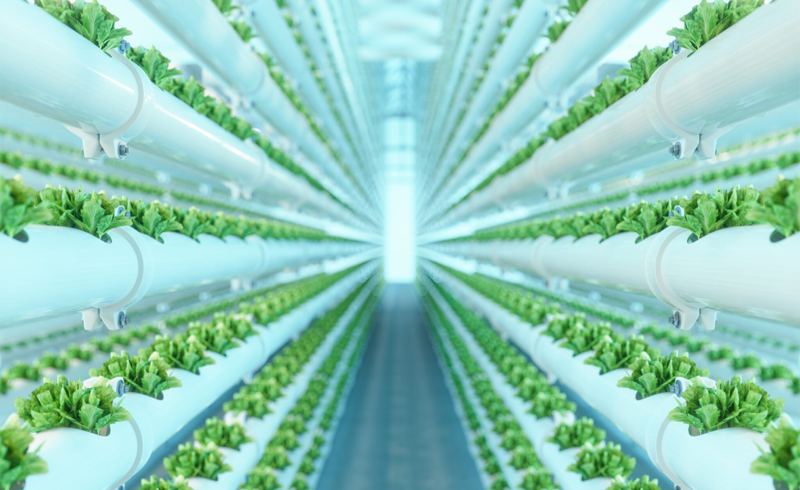The Rise of Vertical Farming: A Sustainable Solution to Global Food Challenges
October 20, 2024

As the world’s population continues to grow, so does the demand for food. By 2050, the global population is expected to reach nearly 10 billion people, and traditional agricultural methods may not be enough to meet this demand. This has sparked a search for innovative solutions to produce more food in a sustainable and efficient manner. One of the most promising advancements in this area is vertical farming—a cutting-edge farming method that is revolutionizing how we grow food in urban environments.
In this article, we’ll explore what vertical farming is, how it works, and why it’s poised to play a significant role in addressing global food challenges.
What is Vertical Farming?
Vertical farming is a method of growing crops in vertically stacked layers, often integrated into urban environments. Unlike traditional farming, which requires vast expanses of land, vertical farms use much less space, making them ideal for densely populated cities. This form of agriculture takes advantage of modern technology, including artificial lighting, climate control systems, and hydroponic or aeroponic growing methods, to cultivate crops in a controlled indoor environment.
Key Characteristics of Vertical Farming:
- Stacked Layers: Crops are grown in multiple layers or shelves, often within tall buildings or repurposed warehouses.
- Hydroponics and Aeroponics: Instead of soil, plants are grown in nutrient-rich water (hydroponics) or sprayed with a nutrient mist (aeroponics).
- Controlled Environment: Vertical farms maintain precise control over factors like light, temperature, humidity, and CO2 levels, creating optimal growing conditions year-round.
- Energy-Efficient Lighting: LED lights provide the necessary spectrum of light for photosynthesis, often tailored to the specific needs of different crops.
How Vertical Farming Works
Vertical farming leverages advanced technologies to create optimal growing conditions for plants, regardless of the external environment. This method can be deployed in urban areas, reducing the need for long-distance transportation and enabling local, fresh produce year-round.
1. Hydroponic and Aeroponic Systems
In vertical farming, plants are grown without soil. Instead, they are cultivated using hydroponic or aeroponic systems, both of which provide essential nutrients to the plants.
- Hydroponics: In hydroponic systems, plants are grown in water that is enriched with nutrients. The roots of the plants absorb the nutrients directly from the water, allowing them to grow faster than in soil. Since hydroponics recirculates water, it uses up to 90% less water than traditional farming methods.
- Aeroponics: In aeroponics, the roots of the plants are suspended in the air and misted with a nutrient-rich solution. This method is highly efficient, as it uses even less water than hydroponics and allows for faster growth due to better oxygenation of the roots.
2. Artificial Lighting and Climate Control
To grow plants indoors, vertical farms rely on artificial lighting, typically LED lights that are customized to provide the ideal spectrum of light for photosynthesis. These lights are energy-efficient and can be programmed to mimic natural sunlight or provide more targeted wavelengths for specific crops.
The controlled environment of vertical farms also includes precise regulation of temperature, humidity, and CO2 levels, allowing for year-round production. This means crops can be grown regardless of the season, weather conditions, or external environmental factors.
3. Automation and Data-Driven Agriculture
Many vertical farms use automation and data analytics to optimize the growing process. Sensors monitor plant health, soil conditions (if used), and environmental factors in real-time. AI and machine learning algorithms can then analyze this data to make adjustments, ensuring optimal growth and minimizing resource use.
For example, automated irrigation systems can deliver the exact amount of water and nutrients needed by each plant, while climate control systems can adjust temperature and humidity based on the specific needs of the crop. These technologies not only improve efficiency but also reduce the potential for human error in the farming process.
The Environmental Benefits of Vertical Farming
One of the key drivers behind the rise of vertical farming is its potential to offer a more sustainable and environmentally friendly alternative to traditional agriculture. Here are some of the key environmental benefits of vertical farming:
1. Water Conservation
Water scarcity is one of the most pressing global challenges, particularly in regions where agriculture is a major water consumer. Traditional farming methods rely heavily on irrigation, which can lead to water wastage through evaporation and runoff. Vertical farming, by contrast, uses significantly less water, thanks to its closed-loop systems like hydroponics and aeroponics.
- 90% Less Water Usage: Vertical farms use up to 90% less water than traditional farming, making them a sustainable option for growing food in areas facing water shortages.
2. Reduction in Land Use
As global populations grow, the demand for arable land increases, leading to deforestation and habitat destruction. Vertical farming addresses this issue by requiring significantly less land to produce the same amount of food. By growing crops in stacked layers, vertical farms can produce high yields within a small footprint, making it possible to grow food in urban areas or repurposed industrial spaces.
3. Elimination of Pesticides
Because vertical farms are grown in controlled indoor environments, they are less vulnerable to pests and diseases. This eliminates the need for harmful pesticides and herbicides, making vertical farming a more eco-friendly option that reduces the chemical impact on both the environment and human health.
4. Reduction in Food Miles
One of the major environmental costs associated with traditional agriculture is the transportation of food over long distances, often referred to as “food miles.” Vertical farms can be located in or near urban areas, allowing for local food production and significantly reducing the distance food travels from farm to table. This reduces the carbon emissions associated with transportation and provides fresher produce to consumers.
Economic and Social Impact of Vertical Farming
While the environmental benefits of vertical farming are clear, it also offers significant economic and social advantages, particularly in addressing global food security.
1. Urban Food Security
With more than half of the world’s population living in urban areas, vertical farming provides a solution for local food production in cities, where land is limited, and space is at a premium. By producing food closer to where people live, vertical farming helps reduce reliance on rural agriculture and long supply chains, improving food security in cities.
2. Job Creation and Innovation
The rise of vertical farming is also driving job creation and innovation in agriculture. These farms require workers with expertise in technology, engineering, and plant science, leading to new career opportunities in urban areas. Additionally, as vertical farming continues to grow, it encourages innovation in sustainable agricultural practices, creating opportunities for research and development.
3. Year-Round Production
Traditional farming is often limited by seasons and weather conditions, making it difficult to grow certain crops year-round. Vertical farms, however, can operate continuously, producing fresh food regardless of external factors. This consistent production can help stabilize food prices and ensure a steady supply of produce in areas prone to extreme weather or climate-related disruptions.
Challenges Facing Vertical Farming
While vertical farming offers numerous benefits, there are still challenges that must be addressed for it to become a mainstream solution to global food challenges.
1. High Energy Consumption
One of the biggest criticisms of vertical farming is its reliance on artificial lighting, climate control, and automation, which require significant energy. While LED lights are energy-efficient, powering a large-scale vertical farm can still lead to high energy costs. For vertical farming to be truly sustainable, further advancements in renewable energy integration and energy-efficient technologies are needed.
2. High Initial Costs
Setting up a vertical farm requires significant investment in infrastructure, technology, and maintenance. The cost of land in urban areas, along with the need for sophisticated growing systems and automation, can make vertical farming prohibitively expensive for many farmers. However, as the technology matures and economies of scale are realized, these costs may decrease.
3. Crop Variety Limitations
Currently, vertical farming is best suited for certain types of crops, particularly leafy greens, herbs, and small vegetables like tomatoes and cucumbers. While these crops can be grown efficiently in vertical farms, staple crops like wheat, corn, and rice are less feasible due to their space and nutrient requirements. Expanding the range of crops that can be grown in vertical farms remains a challenge for the future.
The Future of Vertical Farming
Despite the challenges, vertical farming is poised to play an important role in the future of agriculture. As technology continues to advance, we can expect vertical farms to become more energy-efficient, cost-effective, and capable of producing a wider variety of crops. With the global population continuing to rise and the pressure on natural resources increasing, vertical farming offers a sustainable solution to feeding the world in the coming decades.
From reducing environmental impact to providing food security in urban areas, vertical farming is more than just a trend—it’s a viable, long-term strategy for addressing some of the biggest challenges facing global agriculture today.







